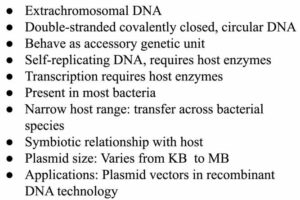
- The term “Plasmid” was first coined by Joshua Lederberg in 1952 (Lederberg, 1952).
- Plasmids are extrachromosomal, double-stranded, covalently closed circular DNA molecules.
- Although most plasmids are covalently closed, linear plasmids have also been reported.
- Plasmid size varies a lot, ranging from kilobases to megabases.
- They are present in most bacteria (both gram-positive and gram-negative) where they behave as an accessory genetic unit and have the ability to inherit independently of chromosomal DNA. Some other organisms such as archaea and lower eukaryotes (e.g., yeast) also contain plasmids.
- Plasmids can coexist with other plasmids in the same cell. For example, Borrelia burgdorferi has been reported to have at least 20 different plasmids.
- Most plasmids have a symbiotic relationship with their host.
- They are capable of autonomous replication and possess basic replication machinery to control their own replication but require host proteins and enzymes for DNA synthesis.
- Most plasmids such as ColE1, pBR322, and pUC18 have a narrow host range, which means that exist only in related bacterial species.
- Although plasmids are not essential for the survival of bacteria, they contribute by providing some functions (plasmid-encoded traits) that can be advantageous to the host cell in certain circumstances such as in presence of antibiotics or bacteriophage attack.
- Plasmids carry genes, which encode proteins that are necessary for plasmid-encoded traits such as resistance to antibiotics, heavy metals, and bacteriophages. Plasmid genes require host proteins for transcription.

REFERENCES
- Lederberg, 1952. Cell genetics and hereditary symbiosis. Physiol Rev. 32(4), 403-30. PMID-13003535; Full-Text Links: physiology, nih.gov (Download PDF)
Was this post helpful?
Let us know if you liked the post. That’s the only way we can improve.
1 thought on “Plasmid”